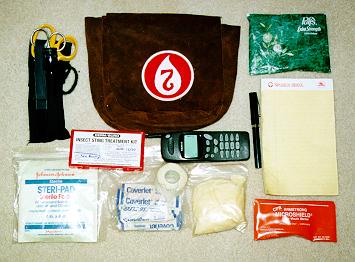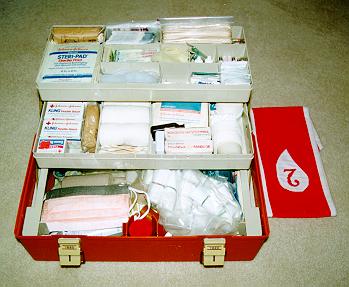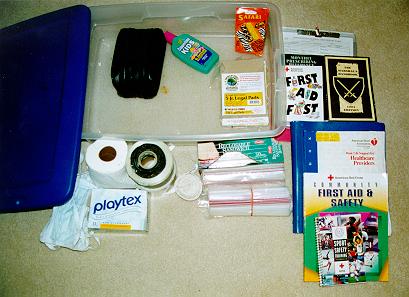

Belt Pouch


Baldric Stethoscope Trauma dressing 4X4s 2X3" Bandaids Scalpel Blades (#11 and #15) – no, I’m not doing surgery outside the hospital. I have many uses for these sharp items, but again, not recommended for general use. Here's the scalpel blade I prefer to use! Bandaids (assorted sizes) Oropharyngeal airways (infant through large adult sizes) Gloves Hard candies – good for hypoglycemia as well as to make your own breath a bit more presentable when you are called out in the middle of the night. Pen light Pens and pencils Chapstick – this is an item you would give away. Don’t let someone use it then put it back in the kit! Nail clippers Fine forceps Tongue blades Various hypodermic needles – mostly for removing splinters Eye drops Tincture of Benzoin – this helps tape stick to sweaty people. I have small ampules that you squeeze between your fingers and then dab directly on the skin Pre-moistened towelettes Alcohol prep pads – for cleaning any of my equipment that is not disposable. Since I’m not doing any invasive procedures, I shouldn’t have to use any skin disinfectants. 2" Kling 3" Kling 4" Kling 4" Kerlex Q-tips Eye pads Triangular bandages Dental Floss Syrup of Ipecac 1" Tape 2" Tape Contact lens case Surgical mask with eye shield Roller Bandages CPR Pocket Mask Surgical Gloves Tourniquet (blood-drawing type) – This would not work as tourniquet for stopping bleeding. I would use this as a constricting band, e.g., in case of snake bite. Waterless antibacterial hand cleanser 2" Elastic bandage 3" Elastic bandage 4" Elastic Bandage Safety pins Bite stick ABD pads Adolph’s Meat Tenderizer – I use this for stings. The poison in a sting is a protein, and the meat tenderizer is a proteolytic enzyme – it breaks down proteins. I haven’t seen any scientific trials on this, but it makes sense.

Here’s
my philosophy on OTC meds. I have
stopped carrying any to events. I had very few requests and I was
throwing away more expired meds than I was using. If you wish to keep
meds around, cover the most common things that would require drugs:
headache, upset stomach, cold symptoms, allergies, and skin rashes.
Refer
to the Chirurgeon’s Handbook for the Society policy on OTC
meds. Get
generic
drugs (such as Wal-Mart brand). They are much cheaper and contain the
same
ingredients as the brand-name product. You should also avoid liquid
medicines
(harder to dispense in a sanitary fashion). The ideal would be unit
dose
packages like they use in hospitals which are available from health and
safety supply houses.

| ARC First Aid Kit recommendations |
|
|
First aid kits are available in most department stores starting at about $10 for a decent kit. Medic supply stores carry extensive kits costing hundreds of dollars. Imagination and innovation can put a kit together much cheaper. My roller bandages are made from an old sheet. Ask health care providers if they would be willing to donate some supplies to a volunteer for a non-profit organization (but please don't ask employees to steal materials to stock your kit!). If you have access to pharmaceutical company representatives that manufacture OTC meds, they might be able to give you samples (I've gotten a box of packets of 2 Advil each via this route).
I welcome a discussion of kit contents on the chirurgeon mailing list (http://groups.yahoo.com/group/SCA-Chirurgeon). I would especially be interested in hearing about what non-standard first aid supplies you carry to take care of SCA-specific problems.
In service to Physick and Chirurgy,
Return to the Chirurgeon's Point